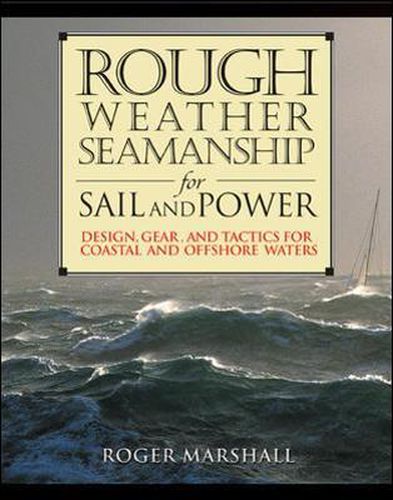Readings Newsletter
Become a Readings Member to make your shopping experience even easier.
Sign in or sign up for free!
You’re not far away from qualifying for FREE standard shipping within Australia
You’ve qualified for FREE standard shipping within Australia
The cart is loading…






Any boater who leaves the harbor is eventually going to end up in rough weather. A few will find themselves in genuinely life-threatening situations. To respond correctly, you need more than grit. You need a properly equipped, seaworthy boat, and you need to have mastered a body of specialized knowledge and techniques rarely covered in the boating press. IM’s only title in this area, Adlard Coles’ Heavy Weather Sailing, has sold more than 100,000 copies over its lifetime, suggesting that boaters take the threat of heavy weather seriously and are prepared to do their homework. Roger Marshall’s Rough Weather Seamanship for Sail and Power is more accessible to the beginner, addresses near-shore as well as offshore scenarios, and covers powerboats as well as sail. An accomplished naval architect, Roger Marshall first concentrates on the boat - how to select and modify a boat with heavy weather in mind. For the sailor that might mean choosing a fairly heavy boat with a substantial keel, reefing gear (to reduce sail area) and heavy-duty storm sails. The powerboater will want reserve buoyancy in the bow, stability at low running speeds, and perhaps twin engines. Both will look for stability, top quality construction, adequate power, and a deck layout that sheds water while still protecting the crew. Both should carry devices such as drogues and sea anchors to help control the boat in severe conditions. Next the book examines the storm itself - how storms are formed, how to track them, and the dangerous winds and seas they produce. Then Marshall combines these elements in later chapters and considers heavy weather tactics and techniques in detail. The best approach, of course, is to avoid the storm altogether. If that proves impossible, most skippers attempt to maneuver out of the storm under reduced sail or power. Great care must be taken to hold the boat at a safe angle to the seas, match the boat’s speed to the swells, and dodge breaking or irregular seas. Finally, if conditions deteriorate to the point that such active measures are impossible, one must resort to passive tactics, such as heaving-to or lying to a sea anchor, in which the boat is immobilized with its bow to the seas and left to fend for itself. Along the way sidebars present the reader with realistic decision-making exercises to highlight the many factors one must consider and encourage strategic thinking. Other topics include: near-shore heavy weather tactics, preparing for a storm in port, preventing seasickness, dealing constructively with fear, maintaining morale, recovering crew overboard, damage control, abandoning ship, and search and rescue organizations and their procedures.
$9.00 standard shipping within Australia
FREE standard shipping within Australia for orders over $100.00
Express & International shipping calculated at checkout
Any boater who leaves the harbor is eventually going to end up in rough weather. A few will find themselves in genuinely life-threatening situations. To respond correctly, you need more than grit. You need a properly equipped, seaworthy boat, and you need to have mastered a body of specialized knowledge and techniques rarely covered in the boating press. IM’s only title in this area, Adlard Coles’ Heavy Weather Sailing, has sold more than 100,000 copies over its lifetime, suggesting that boaters take the threat of heavy weather seriously and are prepared to do their homework. Roger Marshall’s Rough Weather Seamanship for Sail and Power is more accessible to the beginner, addresses near-shore as well as offshore scenarios, and covers powerboats as well as sail. An accomplished naval architect, Roger Marshall first concentrates on the boat - how to select and modify a boat with heavy weather in mind. For the sailor that might mean choosing a fairly heavy boat with a substantial keel, reefing gear (to reduce sail area) and heavy-duty storm sails. The powerboater will want reserve buoyancy in the bow, stability at low running speeds, and perhaps twin engines. Both will look for stability, top quality construction, adequate power, and a deck layout that sheds water while still protecting the crew. Both should carry devices such as drogues and sea anchors to help control the boat in severe conditions. Next the book examines the storm itself - how storms are formed, how to track them, and the dangerous winds and seas they produce. Then Marshall combines these elements in later chapters and considers heavy weather tactics and techniques in detail. The best approach, of course, is to avoid the storm altogether. If that proves impossible, most skippers attempt to maneuver out of the storm under reduced sail or power. Great care must be taken to hold the boat at a safe angle to the seas, match the boat’s speed to the swells, and dodge breaking or irregular seas. Finally, if conditions deteriorate to the point that such active measures are impossible, one must resort to passive tactics, such as heaving-to or lying to a sea anchor, in which the boat is immobilized with its bow to the seas and left to fend for itself. Along the way sidebars present the reader with realistic decision-making exercises to highlight the many factors one must consider and encourage strategic thinking. Other topics include: near-shore heavy weather tactics, preparing for a storm in port, preventing seasickness, dealing constructively with fear, maintaining morale, recovering crew overboard, damage control, abandoning ship, and search and rescue organizations and their procedures.